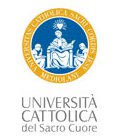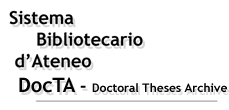|
|
DocTA - Doctoral Theses Archive >
Tesi di dottorato >
SCUOLA DI DOTTORATO IN SISTEMA AGRO-ALIMENTARE >
Citazione:
Utilizza queste indicazioni per citare o creare un link a questo documento.
|
Carletti, Giorgia. "MOLECULAR BIOLOGY OF ANTHOCYANIN IN PRODUCTION IN PLANTS", Università Cattolica del Sacro Cuore, XXII ciclo, a.a. 2008/09, Piacenza, [http://hdl.handle.net/10280/785].
|
| Titolo: | MOLECULAR BIOLOGY OF ANTHOCYANIN IN PRODUCTION IN PLANTS |
| Autore/i: | CARLETTI, GIORGIA |
| Tutor: | MAROCCO, ADRIANO |
| Coordinatore: | PIVA, GIANFRANCO |
| Lingua: | ENG |
| Abstract in italiano della tesi: | le antocianine sono una classe di metaboliti secondari nelle piante, appartenenti ai flavonoidi, categoria di molecole antiossidanti utili per la salute di piante, animali e umana. Sono ampiamente studiati nelle Leguminosae poiché implicati in numerose funzioni fisiologiche. In questa tesi, due wild-types e cinque mutanti di Medicago truncatula, coinvolti nel metabolismo dei flavonoidi, sono stati caratterizzati a livello fenotipico, fisiologico e molecolare. La principale differenza tra i wild-type e i mutanti è la riduzione del contenuto di antocianine nelle foglie. In seguito all'esposizione alle radiazioni UV-B, è stata analizzata la loro risposta, evidenziando un diverso comportamento. Inoltre, il metabolismo delle antocianine è stato studiato anche a livello di regolazione genica e un nuovo gene myb è stato isolato e caratterizzato, risultando più espresso nei tessuti che accumulano antocianine. |
| Abstract in inglese: | Anthocyanins are secondary metabolites in plants. They belong to a class of flavonoids synthesized via the phenylpropanoid pathway and they are antioxidant molecules important for plant, animal and human health. Flavonoids are widely studied in legume because they are implicated in several biological and physiological functions. In this thesis seven genotypes (two wild-types and five indipendent mutants) of Medicago truncatula (the model legume plant) affected in flavonoid metabolism have been characterized at phenotypic, physiological and molecular level. The main difference between wild-types and mutants, is the reduction in anthocyanin content in leaves. The anthocyanin accumulation during the leaf life, the flowering time and the fruit formation have been registered and compared. The two wild-types contain 6 μg cyanidin.mg-1 of fresh weight, while in the mutants the anthocyanin amount ranged from 0.12 μg cyanidin mg-1 to 2 μg cyanidin mg-1 of fresh weight. After HPLC-DAD-MS/MS analysis, the main anthocyanin present in the two wild-types is the cyanidin-3-O feruloyl. The Expression profile of genes codifying enzymes and transcriptional factor involved in flavonoid biosynthesis has been investigated. RT-PCR and qPCR results show different possible pathways of reduction of anthocyanins in the five mutants. These mutants, have been exposed to UV-B radiations and their response has been investigated measuring the chlorophyll fluorescence parameters (Fv/Fm, qP and NPQ) in untreated plants, during treatment (after 4hrs and 14hrs of treatment) and in the recovering phase. All genotypes, regardless of the anthocyanins amount, showed a decrease of the photosyntetic efficiency after 14hrs of treatment. This indicates a marginal role of these pigments in the oxidative damages protection. Mutants do not response in the same manner to the UV—B exposure and the anthocyanin amount does not increase equally in all genotypes. The anthocyanin metabolism is studied also at the gene regulation level. A novel Myb gene (MtMYBA) involved in anthocyanin pathway has been isolated and characterized. This gene is more expressed in tissues which accumulate anthocyanins in M. truncatula plants. The functional analysis has been investigated overexpressing this Myb gene under the control of 35S promoter. This construct has been used to transform Arabisopsis thaliana and Medicago truncatula plants. In addition, the MtMYBA promoter has been cloned in a plasmids containing GUS and GFP reporter genes. |
| Digital Object Identifier (DOI): | http://dx.doi.org/10.1007/s11032-008-9196-0
http://dx.doi.org/10.1016/j.jplph.2009.09.009 |
| Data di discussione: | 22-apr-2010 |
| URI: | http://hdl.handle.net/10280/785 |
| È visualizzato nelle collezioni: | SCUOLA DI DOTTORATO IN SISTEMA AGRO-ALIMENTARE
FACOLTA' DI AGRARIA
|
File in questo documento:
| File |
Dimensioni | Formato | Accessibilità |
|---|
| Testo completo.pdf | 47,11 MB | Adobe PDF | Visualizza/apri
|
|
Accesso e utilizzo dei contenuti di DocTA
|



